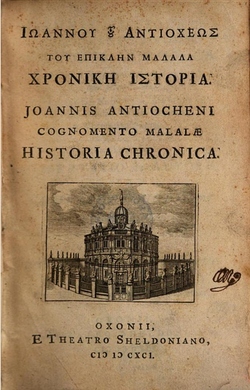Writing

He wrote a Chronographia (Χρονογραφία) in 18 books, the beginning and the end of which are lost. In its present state it begins with the mythical history of Egypt and ends with the expedition to Roman Africa under the tribune Marcianus, Justinian's nephew, in 563 (his editor Thurn believing it originally to end with Justinian's death[6]); it is focused largely on Antioch and (in the later books) Constantinople. Except for the history of Justinian and his immediate predecessors, it possesses little historical value; the author, "relying on Eusebius of Caesarea and other compilers, confidently strung together myths, biblical stories, and real history."[7] The eighteenth book, dealing with Justinian's reign, is well acquainted with, and colored by, official propaganda. The writer is a supporter of Church and State, an upholder of monarchical principles. However, the theory identifying him with the patriarch John Scholasticus is almost certainly incorrect.[8]
He used several sources, for example Eustathius of Epiphania and other unknown authors.
The work is important as the first surviving example of a chronicle written not for the learned but for the instruction of the monks and the common people, and its language shows a compromise with the spoken language of the day, although "it is still very much a written style. In particular, he employs technical terminology and bureaucratic clichés incessantly, and, in a period of transition from Latin to Greek governmental terminology, still uses the Latin loanwords alongside their Greek replacements.... The overall impression created by Malálas' style is one of simplicity, reflecting a desire for the straightforward communication of information in the written language of everyday business as it had evolved under the influence of spoken Greek."[9]
It obtained great popularity, and was used by various writers until the ninth century; it was translated into Old Bulgarian probably in the tenth century, and parts of it were used for the Primary Chronicle.[10] It is preserved in an abridged form in a single manuscript now at Oxford (Baroccianus 182) as well as in various fragments. A medieval translation in Georgian also exists.[11]